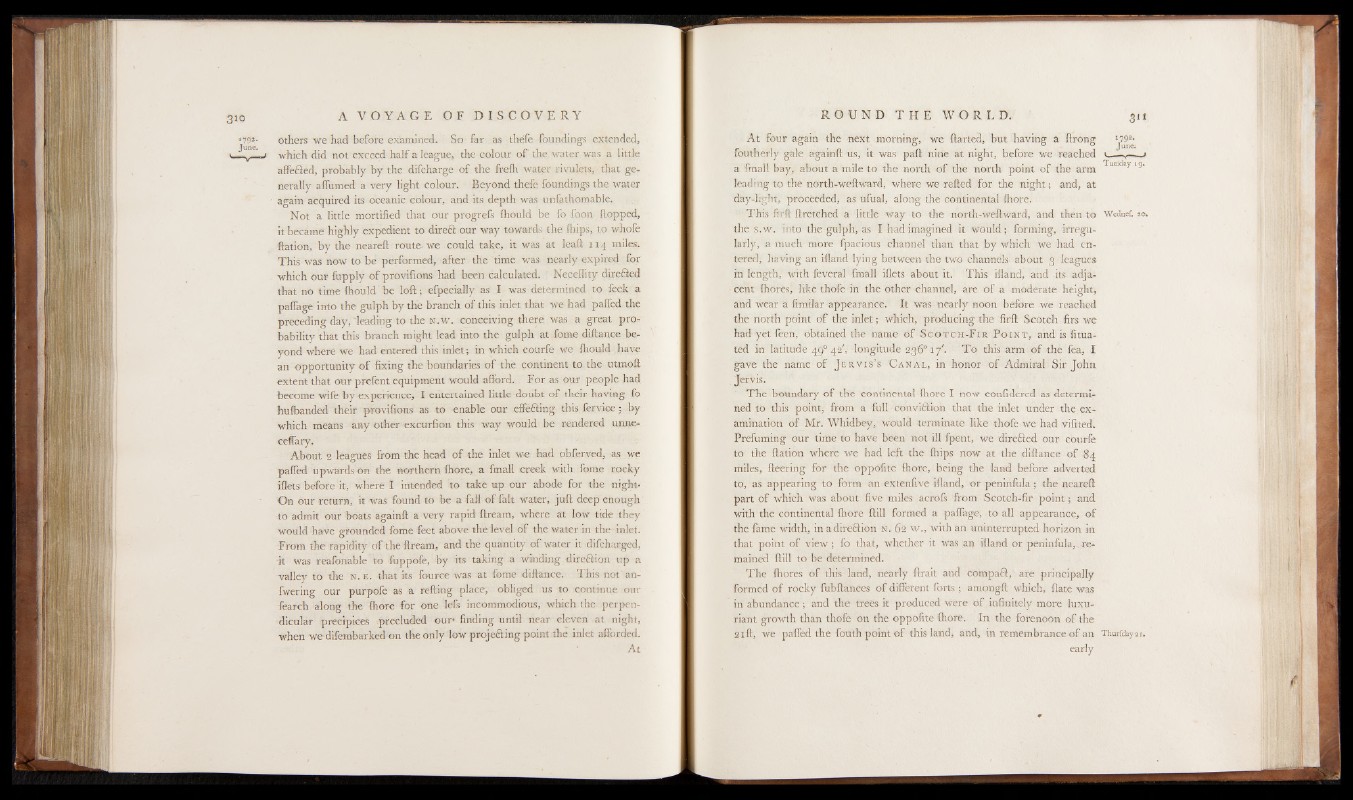
others we had before examined. So far as thefe foundings extended,
which did not exceed half a league, the colour o f the water was a little
affefted, probably by the difcharge of the frelh water rivulets, that generally
alfumed a very light colour. Beyond thefe foundings the water
again acquired its oceanic colour, and its depth was unfathomable.
Not a little mortified that our progrefs Ihould be fo foon Hopped,
it became highly expedient to direft our way towards the fiiips, to whofe
Ration, by the nearelt route, we could take, it was at leaft 114 miles.
This was now to be performed, after the time was nearly expired for
which our fupply of provifions had been calculated. Necelfity directed
that no time Ihould be loft; efpecially as I was determined to feelt a
paffage into the gulph by the branch of this inlet that we had paffed the
preceding day, 'leading to the N.w. conceiving there was a great, probability
that this branch might lead into the gulph at fome diftance beyond
where we had entered this inlet; in which courfe we Ihould have
an opportunity o f fixing the boundaries o f the continent to the utmoft
extent that our prelent equipment would afford. For as our people had
become wife by experience, I entertained little -doubt of their having fo
hulbanded their provifions as to enable our effecting this fervice 5 .by
which means any other excurfion this way would be rendered urtneceffary.
About 2 leagues from the head of the inlet we had obferved, as we
palfed upwards on the northern fhore, a fmall creek with fome rocky
iflets before it, where I intended to take up our abode for the -night-
On our return, it was found to be a fall of fait water, juft deep enough
to admit our boats againft a very rapid ftream, where at low tide they
would have grounded fome feet above the level of the water in the inlet.
From the rapidity Of the ftream, and the quantity of water it difcharged,
it was reafonable to fuppofe, by its taking a winding -direction up a
valley to the n . e . that its fource was at fome diftance. This not an-
fwering our purpofe as a refting place, obliged us to continue our
fearch along the Ihore for one lefs incommodious, which the perpendicular
precipices precluded our* finding until near eleven at night,
when we difembarked on the only low projeffing point the inlet afforded.
At
At four again the next morning, we ftarted, but having a ftrong
foutherly gale againft us, it was paft nine at night, before we reached
a fmall bay, about a mile to the north of the north point of the arm
leading to the north-weftward, where we refted for the night; and, at
day-light, proceeded, as ufual, along the continental Ihore.
This firft ftretched a little way to the north-weftward, and then to
the s.w. into the gulph, as I had imagined it would; forming, irregularly,
a much more fpacious channel than that by which we had entered,
having an ifland lying between the two channels about 3 leagues
in length, with feveral fmall iflets about it. This ifland, and its. adjacent
Ihores, like thofe in the other channel, are of a moderate height,
and wear a fimilar appearance. It was nearly noon before we reached
the north point o f the inlet; which, producing the firft Scotch firs we
had yet feen, obtained the name o f S c o t c h - F i r P o i n t , and is Situated
in latitude 4Q0 42', longitude 23,6° 17'. To this arm o f the fea, I
gave the name of J e r v i s ’ s C a n a l , in honor of Admiral Sir John
Jervis.
The boundary o f the continental Ihore I now confidered as determined
to this point, from a full conviction that the inlet under the examination
of Mr. Whidbey, would terminate like thofe we had vifited.
Prefuming our time to have been not ill fpent, we direfited our courfe
to the ftation where we had left the fliips now at the diftance of 84
miles, fleering for the oppofite fhore, being the land before adverted
to, as appearing to form an extenfive ifland, or peninfula; the neareft
part o f which was about five miles acrofs from Scotch-fir point; and
with the continental fhore ftill formed a paffage, to all appearance, o f
the fame width, in adireClion N. 62 w., with an uninterrupted horizon in
that point o f view ; fo that, whether it was an ifland or peninfula,. re-
>792.
June;
Tuelday 19*
mained ftill to be determined.
The fhores of this land, nearly ftrait and compafit, are principally
formed of rocky fubftances o f different forts ; amongft which, flate was
in abundance; and the trees it produced were of infinitely more luxuriant
growth than thofe on the oppofite fhore. In the forenoon of the
21ft, we paffed the fouth point of this land, and, in remembrance o f an Thurfdayai.
early